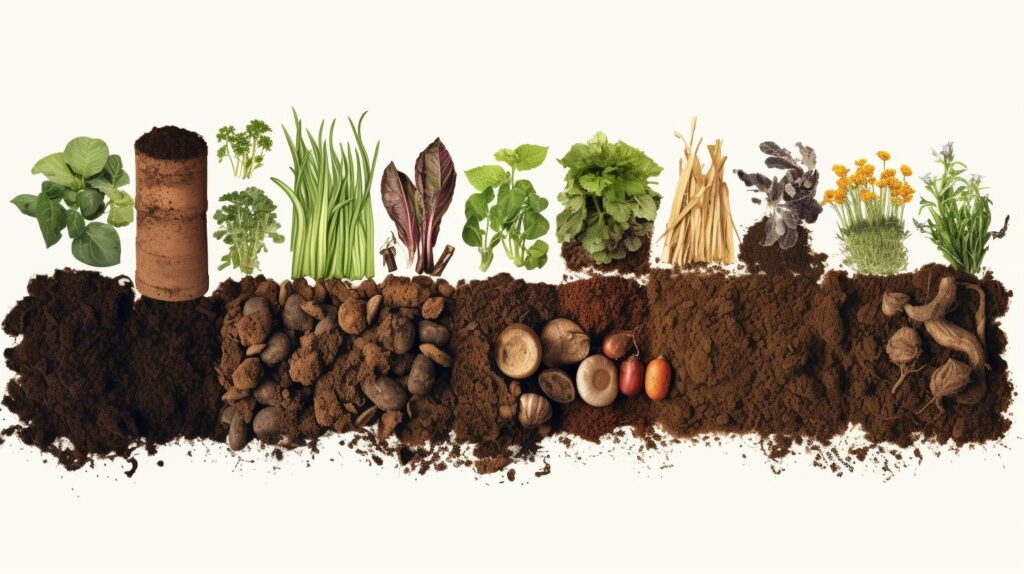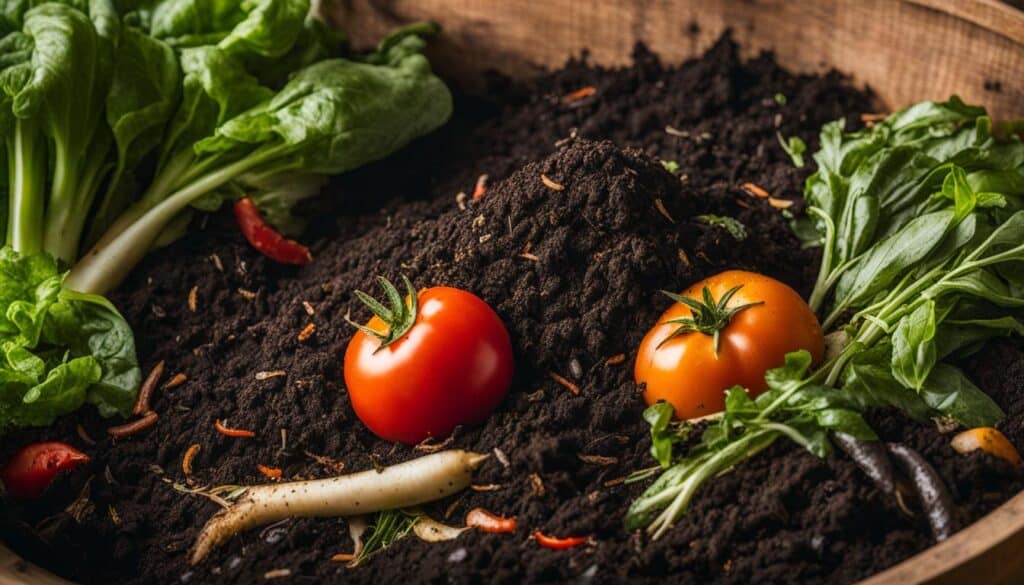In this article let’s cover the different types of compost for a healthy garden. Compost is a wonderful way to nourish your garden with nutrients and organic matter. By using different types of compost, you can provide your plants with the essential elements they need to thrive.
There are various options available when it comes to composting, each with its own advantages and considerations. From traditional composting to vermicomposting, trench composting to sheet mulching, and many more, it’s important to understand the differences and benefits of each method.
In this article, I will explore the various types of compost, including organic compost, vermicompost, manure compost, green compost, brown compost, kitchen compost, backyard compost, and compost tea. By learning about these different types of compost, you can choose the best composting method for your specific needs and gardening goals.
Why Your Should Know:
- Compost is a fantastic way to supply nutrients and organic matter to your garden.
- There are various types of compost available, including traditional composting, vermicomposting, trench composting, and sheet mulching, among others.
- Each type of compost has its own benefits and considerations, so it’s important to choose the right one for your specific needs and gardening goals.
- Some popular types of compost include organic compost, vermicompost, manure compost, green compost, brown compost, kitchen compost, backyard compost, and compost tea.
- Experiment with different composting methods to find what works best for your garden and watch your plants thrive in the healthy soil you’ve created.
Traditional Composting
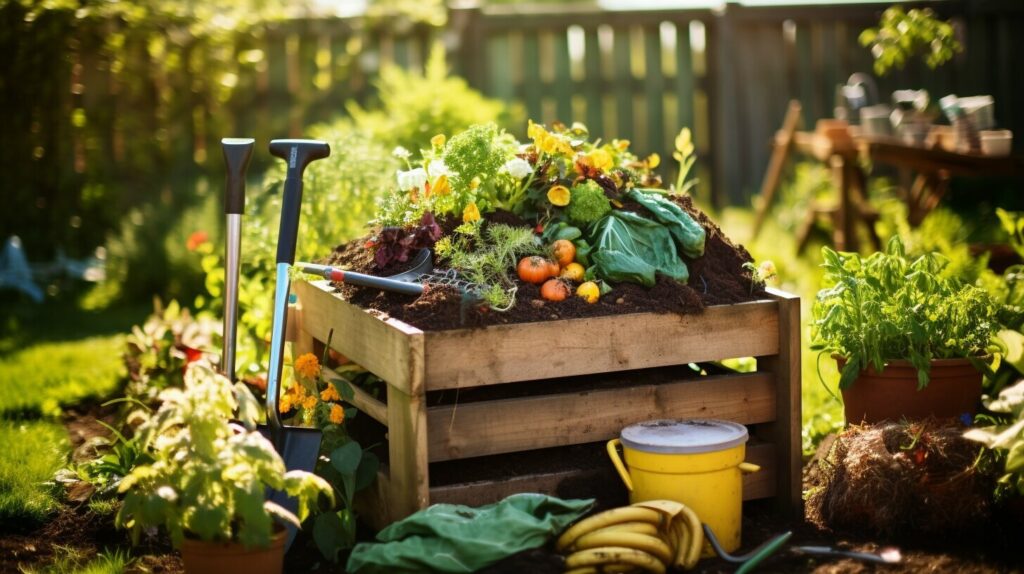
Traditional composting is the most common and widely used method of composting. It involves creating a backyard compost pile or bin where organic materials are piled up and left to decompose over time. This process helps break down the organic matter, resulting in nutrient-rich compost that can be used to improve soil fertility.
Backyard composting is a simple and effective way to recycle kitchen scraps, yard waste, and other organic materials. By composting these materials, you not only reduce waste going to landfills but also create a valuable resource for your garden. The organic matter in the compost adds nutrients to the soil, enhancing its fertility and promoting healthy plant growth.
To start traditional composting, you need a designated composting area or bin. The bin can be made of various materials such as wood, plastic, or wire mesh. As you accumulate organic materials like fruit and vegetable scraps, coffee grounds, eggshells, and yard waste, add them to the compost bin. It’s important to maintain a balance of green (nitrogen-rich) and brown (carbon-rich) materials to ensure proper decomposition. Green materials include fresh grass clippings, vegetable scraps, and plant trimmings, while brown materials include dry leaves, straw, and shredded newspaper.
Regularly turning the compost pile with a pitchfork or shovel helps aerate the pile, speeding up decomposition and preventing unpleasant odors. The composting process typically takes several months to a year, depending on factors such as temperature, moisture levels, and the types of materials added. Once the compost has turned into a dark, crumbly, earthy-smelling substance, it is ready to be used in your garden to improve soil quality and provide essential nutrients to your plants.
| Pros of Traditional Composting | Cons of Traditional Composting |
|---|---|
| Effectively recycles kitchen scraps and yard waste | Can take several months to a year for compost to be ready |
| Improves soil fertility and promotes healthy plant growth | Requires regular turning and maintenance |
| Reduces waste going to landfills | May attract pests if not properly managed |
“Traditional composting is a great way to create nutrient-rich compost for your garden and improve soil fertility.”
Vermicomposting: Worm-Powered Compost
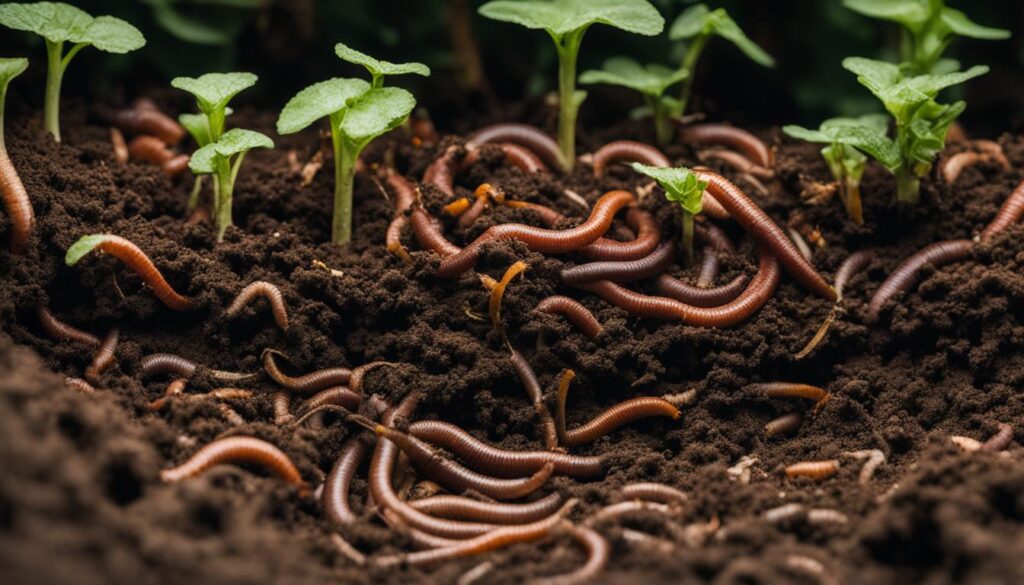
Vermicomposting is an effective method of composting that utilizes worms to break down organic waste materials. It is often done in a worm bin or vermicomposting system, where the worms consume the organic waste and produce nutrient-rich worm castings. This process is ideal for those with limited space or who want to compost indoors. Vermicomposting is not only a sustainable way to recycle kitchen scraps and other organic waste, but it also creates valuable compost that can be used to improve the health and fertility of your garden soil.
“Vermicomposting is the process of using worms to decompose organic materials.”
Vermicomposting has several advantages over traditional composting methods. First, it requires less space and can easily be done in small apartments or homes without a backyard. Second, it has a faster decomposition rate compared to traditional composting, as the worms break down the organic waste more efficiently. Third, vermicompost, or worm castings, has high levels of beneficial microorganisms, enzymes, and plant growth hormones, making it an excellent natural fertilizer for your plants.
When setting up a vermicomposting system, it is important to choose the right type of worms. Red worms (Eisenia foetida or Lumbricus rubellus) are the most commonly used worms for vermicomposting due to their ability to thrive in decomposing organic matter. They are also more efficient at breaking down organic waste compared to regular earthworms. It is recommended to start with a small number of worms and gradually increase their population as they multiply and the composting process progresses.
| Type of Worm | Pros | Cons |
|---|---|---|
| Red Worms (Eisenia foetida) | Efficient composters, reproduce quickly | May die in extreme temperatures |
| European Nightcrawlers (Eisenia hortensis) | Tolerate a wide range of temperatures | Slower composting rate compared to red worms |
| African Nightcrawlers (Eudrilus eugeniae) | Rapid composting rate, tolerate high temperatures | Require warmer conditions to thrive |
Vermicomposting is an efficient way to recycle kitchen scraps and other organic waste, while producing high-quality compost for your garden.
In conclusion, vermicomposting is a sustainable and convenient method of composting that utilizes worms to break down organic waste materials. It is suitable for those with limited space or who prefer to compost indoors. Vermicomposting not only diverts organic waste from landfills but also produces nutrient-rich worm castings that can significantly improve the health and fertility of your garden soil. By implementing vermicomposting, you can contribute to a healthier environment and create a more sustainable garden.
Trench Composting
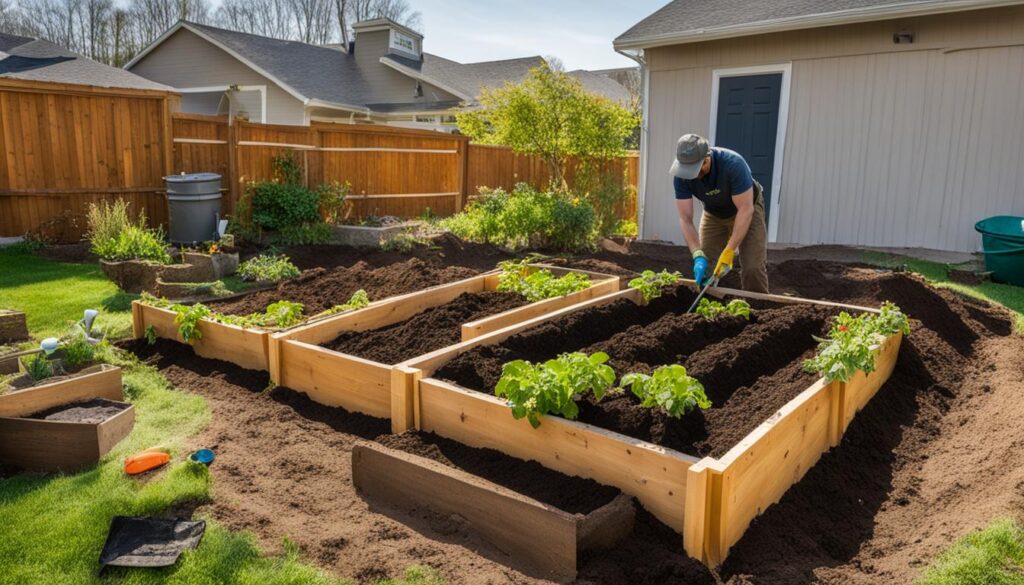
Trench composting is a simple and convenient method of composting that involves burying organic materials directly into your garden bed. By eliminating the need for a compost bin or pile, trench composting provides a seamless way to recycle vegetable scraps and other compostable materials while simultaneously enriching the soil. To get started with trench composting, dig a trench in your garden bed, approximately 12 to 18 inches deep. Then, add your organic materials, such as vegetable scraps, coffee grounds, or yard waste, into the trench. Cover the materials with soil and continue to add layers of organic matter as needed. Over time, the buried compost will break down, releasing nutrients and improving soil structure.
Trench composting offers several advantages. First, it eliminates the need for a compost bin or pile, making it a great option for those with limited space or who prefer a more discreet composting method. Additionally, trench composting allows for a continuous composting process as you can bury materials throughout the growing season. The buried compost also attracts earthworms and other beneficial organisms, further improving the health of your garden soil. Trench composting is especially beneficial for vegetable gardens, as it directly enriches the soil in which your crops are growing.
When trench composting, it’s important to choose suitable materials. Vegetable scraps, fruit peels, coffee grounds, tea leaves, and yard waste are all excellent choices. Avoid adding meat, dairy, or greasy materials, as they can attract pests and result in unpleasant odors. It’s also important to cover the compost materials with soil to prevent any unwanted smells or pests from accessing the organic matter. By following these guidelines, you can successfully implement trench composting in your garden and enjoy the benefits of nutrient-rich, buried compost.
Sheet Mulching (Lasagna Gardening)

Sheet mulching, also known as lasagna gardening, is a popular method of composting that involves layering organic materials to create a composting effect. It is a simple and effective way to improve soil fertility, suppress weeds, and enhance the overall health of your garden. The name “lasagna gardening” refers to the layered approach, similar to the layers of a lasagna dish.
The process starts by laying down a layer of cardboard or newspaper on the ground to smother existing weeds. This acts as a natural weed barrier and helps create a clean slate for your garden bed. On top of the cardboard or newspaper, you can start layering organic materials such as grass clippings, leaves, kitchen scraps, and straw. These layers provide a source of organic matter and nutrients, enriching the soil as they decompose.
Sheet mulching offers several benefits. Firstly, it helps suppress weed growth by blocking sunlight and preventing weed seeds from germinating. This reduces the need for manual weeding and minimizes competition for nutrients and water. Secondly, the organic matter added through sheet mulching improves soil structure, increases moisture retention, and promotes beneficial microbial activity in the soil. Lastly, sheet mulching helps create a nutrient-rich environment for plants to thrive, resulting in healthier and more productive gardens.
Key Advantages of Sheet Mulching:
- Simple and cost-effective way to improve soil fertility
- Suppresses weed growth and reduces the need for manual weeding
- Enhances moisture retention in the soil
- Promotes beneficial microbial activity
- Provides a slow-release source of nutrients for plants
If you’re looking for an easy and efficient way to create compost, suppress weeds, and improve the health of your garden, sheet mulching is an excellent option to consider. By layering organic materials, you can create a nutrient-rich environment that promotes strong plant growth while minimizing the need for excessive maintenance and weed control. Start layering and watch your garden flourish!
| Advantages of Sheet Mulching (Lasagna Gardening) | Disadvantages of Sheet Mulching (Lasagna Gardening) |
|---|---|
|
|
Bokashi Composting
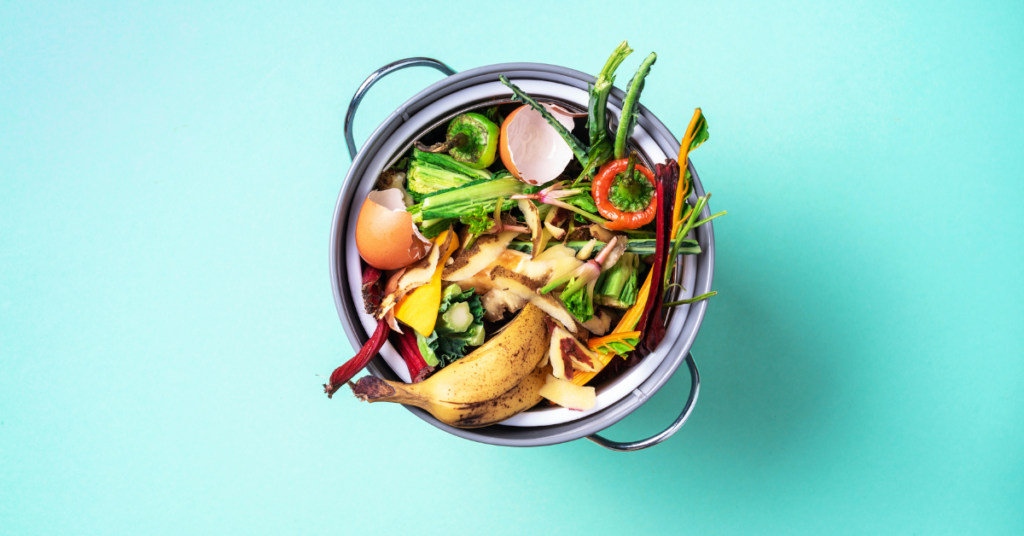
Bokashi composting is an innovative method of composting that offers unique benefits and uses. This Japanese technique utilizes anaerobic fermentation to break down organic waste, including kitchen scraps, into a nutrient-rich compost known as bokashi. Unlike other composting methods, bokashi composting can effectively handle a wide range of kitchen waste, including meat, dairy, and cooked food that may not be suitable for traditional composting.
I find bokashi composting to be an excellent solution for urban dwellers like myself who have limited space and want to compost all types of kitchen waste. The process is simple: I collect my kitchen scraps in an airtight container, known as a bokashi bin, and add bokashi bran, a mix of beneficial microorganisms. The microorganisms rapidly ferment the organic waste, producing a fermented compost that can be buried in the soil or further decomposed in a traditional compost bin.
This anaerobic composting method has the advantage of being odor-free and compact, making it suitable for indoor use. Additionally, bokashi composting breaks down organic waste more quickly compared to traditional composting methods, resulting in a faster turnaround time for nutrient-rich compost. The bokashi compost can be used to enrich the soil in outdoor gardens, potted plants, or even indoor houseplants. It is an effective way to recycle kitchen waste and create a sustainable cycle of nutrient reutilization.
Overall, bokashi composting offers a convenient and efficient way to compost kitchen waste, even in small living spaces. By adopting this anaerobic composting method, I have been able to reduce my household waste significantly and improve the health of my plants with the nutrient-rich bokashi compost. I highly recommend giving bokashi composting a try for those seeking an alternative composting method that addresses the challenges of limited space and diverse kitchen waste.
Pit Composting
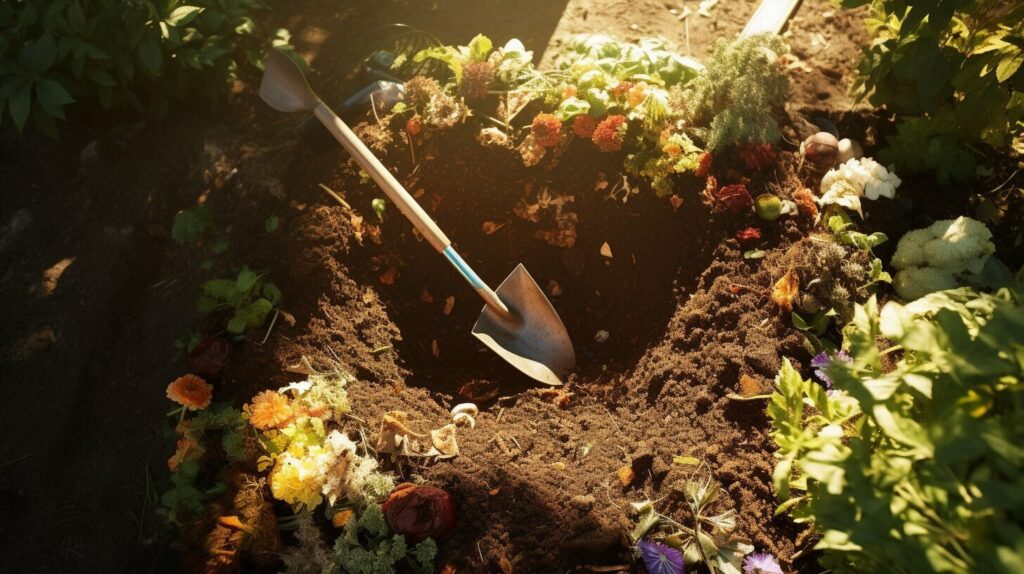
Pit composting, also known as hole composting, is a simple yet effective method of composting that utilizes garden waste and organic matter to improve soil fertility. This technique involves digging a hole in your garden and filling it with compostable materials such as kitchen scraps, yard waste, leaves, and plant trimmings. The hole is then covered with soil, allowing the organic matter to decompose naturally over time.
Pit composting is particularly beneficial for those with limited space or who prefer a more discreet composting method. By composting directly in the soil, you can avoid the need for a compost bin or pile while simultaneously enriching your garden. This process not only reduces waste but also enhances the health and vitality of your plants by providing essential nutrients and organic matter.
Advantages of Pit Composting
- Convenient for composting large amounts of organic waste
- Requires minimal space and equipment
- Improves soil structure and fertility
- Reduces the need for chemical fertilizers
- Sustains a healthy, thriving garden
Implementing pit composting in your gardening routine is a sustainable way to repurpose organic waste while nurturing the health of your plants. By recycling garden waste and creating a nutrient-rich environment, you can contribute to a more sustainable and environmentally friendly lifestyle.
| Advantages of Pit Composting | Description |
|---|---|
| Convenient for composting large amounts of organic waste | Pit composting is an ideal method for composting large quantities of garden waste, making it a suitable choice for those with extensive yards or a surplus of organic materials. |
| Requires minimal space and equipment | Unlike traditional composting methods that require a dedicated compost bin or pile, pit composting can be done directly in your garden, making it a space-efficient option. |
| Improves soil structure and fertility | The organic matter from the compost enriches the soil, enhancing its structure, water-holding capacity, and nutrient content, resulting in healthier and more productive plants. |
| Reduces the need for chemical fertilizers | By providing natural, nutrient-rich compost to your garden, pit composting reduces reliance on synthetic fertilizers, promoting a more sustainable and eco-friendly approach to gardening. |
| Sustains a healthy, thriving garden | Pit composting supports the overall health and vitality of your garden by replenishing essential nutrients, improving soil quality, and fostering beneficial microbial activity. |
Aerated Composting
If you’re looking for a faster and more efficient way to compost, aerated composting is a great option. This method utilizes a compost tumbler or compost bin with built-in aeration systems to accelerate the decomposition process. By providing oxygen to the organic matter, aerated composting promotes accelerated breakdown and helps generate nutrient-rich compost for your garden.
One of the key benefits of aerated composting is its convenience. The compost tumbler or bin takes care of the turning process, eliminating the need for manual turning and regular maintenance. This not only saves you time and effort but also ensures that the compost is well-aerated, preventing any foul odors or pest infestations that can occur with traditional composting methods.
Oxygenation plays a crucial role in aerated composting. The constant airflow in the compost tumbler or bin provides an optimal environment for microorganisms to thrive and break down the organic materials more efficiently. The increased oxygen supply also helps regulate the moisture levels, preventing the compost from becoming too wet or compacted.
“Aerated composting is a great option if you want to compost quickly and avoid the hassle of regular turning. With the help of a compost tumbler or bin, you can enjoy accelerated decomposition and produce nutrient-rich compost for your garden.”
Using a compost tumbler or bin also allows you to have better control over the composting process. You can monitor the temperature, moisture levels, and decomposition progress more easily, enabling you to make any necessary adjustments. This level of control ensures that your composting efforts are optimized, resulting in high-quality compost that can nourish your plants effectively.
| Aerated Composting | Traditional Composting |
|---|---|
| Accelerated decomposition | Slower decomposition |
| No manual turning required | Regular turning necessary |
| Oxygenation promotes beneficial microorganisms | Relies on natural decomposition process |
| Prevents odors and pests | Potential for odors and pests |
Conclusion
Aerated composting offers a convenient and efficient way to produce nutrient-rich compost for your garden. By using a compost tumbler or bin with built-in aeration systems, you can accelerate the decomposition process and enjoy the benefits of well-aerated compost without the need for manual turning. This method gives you greater control over the composting process, ensuring optimal conditions for microorganisms to thrive and break down organic materials efficiently. Consider aerated composting as an effective option if you want to compost quickly and easily while maintaining a healthy garden.
Compost Tea
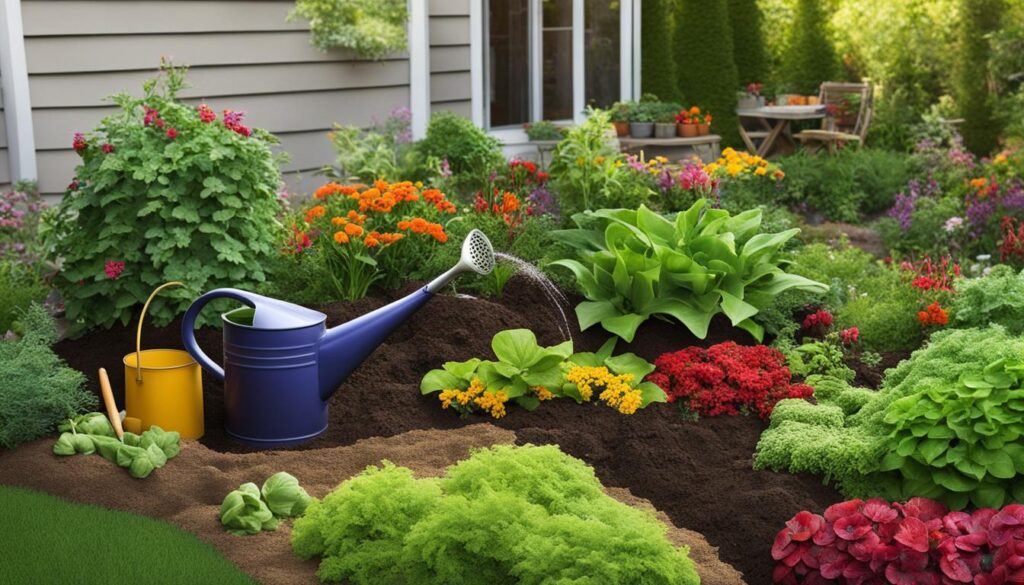
Compost tea is a nutrient-rich liquid fertilizer that can provide your plants with a boost of essential nutrients. It is made by steeping compost in water for a period of time, allowing the nutrients to leach out into the liquid. Compost tea can be used as a foliar spray or soil drench, delivering the benefits of compost directly to the roots of plants and promoting healthy growth.
One of the advantages of compost tea is its versatility. It can be customized to meet the specific needs of your plants by adjusting the compost-to-water ratio and steeping time. Additionally, compost tea can contain a wide range of beneficial microorganisms that contribute to soil health and plant vitality.
When using compost tea as a foliar spray, it is important to apply it during the cooler hours of the day to prevent scorching of the leaves. The liquid compost can also be diluted further to reduce the concentration of nutrients for more delicate plants. Remember to strain the compost tea before application to remove any solid particles that may clog sprayers or drenching systems.
Benefits of Compost Tea:
- Provides plants with essential nutrients
- Improves soil health and structure
- Enhances plant growth and vigor
- Increases the population of beneficial microorganisms
- Reduces the risk of plant diseases and pests
Compost tea is a valuable addition to any gardener’s toolkit. It is an efficient way to recycle organic waste and create a nutrient-rich fertilizer that promotes the overall health and productivity of your plants. Experiment with different brewing methods and application techniques to find the right compost tea formula for your garden’s needs.
| Type of Compost | Application Method | Steeping Time |
|---|---|---|
| Vermicompost | Foliar spray or soil drench | 24-48 hours |
| Manure compost | Soil drench | 48-72 hours |
| Green compost | Foliar spray | 12-24 hours |
| Brown compost | Soil drench | 48-72 hours |
| Kitchen compost | Foliar spray or soil drench | 24-48 hours |
Hot Composting
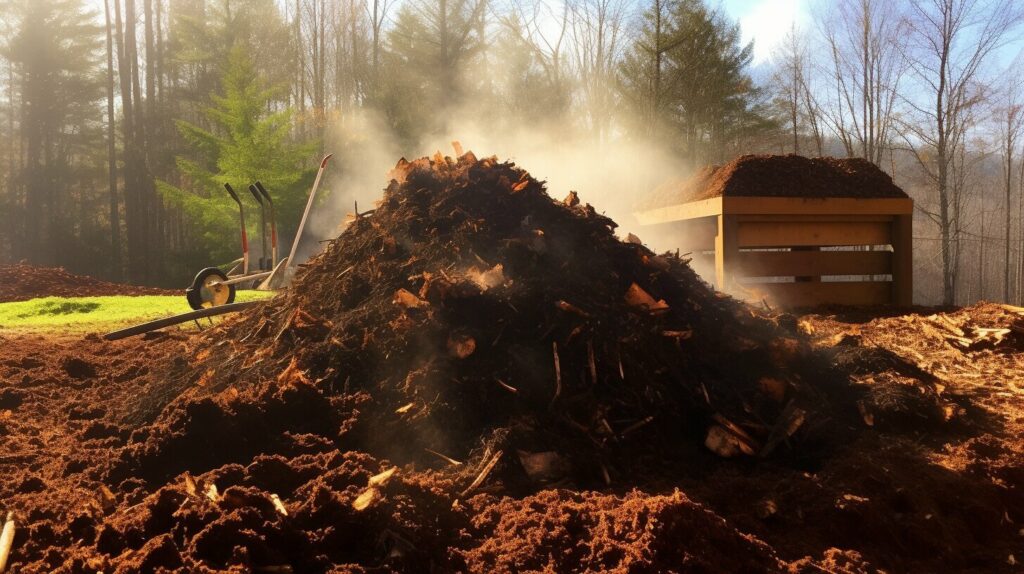
Hot composting is a high-temperature composting method that accelerates the decomposition process, resulting in rapid breakdown of organic materials. This technique requires a balance of nitrogen-rich and carbon-rich materials, regular turning, and proper moisture levels. The heat generated speeds up the breakdown of organic matter, resulting in fast and efficient composting.
One of the key benefits of hot composting is its ability to kill weed seeds and pathogens due to the high temperatures reached during the decomposition process. This makes the resulting compost safe to use in your garden without the risk of introducing unwanted weed seeds or harmful pathogens. Additionally, the high temperatures also break down tough materials, such as woody trimmings or diseased plants, that may not decompose as easily in other composting methods.
To create a hot compost pile, start by layering nitrogen-rich materials, such as fresh grass clippings or kitchen scraps, with carbon-rich materials like dried leaves or straw. The pile should be at least three feet high and three feet wide to ensure proper heat retention. Regularly turn the pile every few days to introduce oxygen and aid in the decomposition process. Keep an eye on the moisture levels, as the pile should be damp but not overly saturated.
The end result of hot composting is a nutrient-rich, dark brown compost that can be used to improve soil fertility, boost plant growth, and enhance overall garden health. By harnessing the power of high temperatures, hot composting offers a fast and effective way to create quality compost for your garden.
Cold Composting

Cold composting is a method of composting that operates at a slower pace compared to other composting techniques. It involves piling up organic materials, such as kitchen scraps, yard waste, and leaves, and allowing them to decompose naturally over time without any specific maintenance or turning. Unlike hot composting, which requires a high temperature to accelerate the decomposition process, cold composting relies on the natural breakdown of organic matter.
This low-maintenance approach to composting is perfect for those who prefer a hands-off method. With cold composting, you can simply add organic materials to your pile and let nature take its course. While it may take longer for the compost to fully mature, this slower decomposition process still results in nutrient-rich compost that improves soil health and supports plant growth.
One of the key benefits of cold composting is its simplicity. You don’t need any fancy equipment or a designated compost bin to get started. Just find a suitable spot in your garden or yard, create a pile, and begin adding organic materials. It’s a sustainable way to reduce waste and create a valuable resource for your garden.
So, if you’re looking for a low-maintenance composting method that allows nature to do the work, cold composting is the way to go. With a little patience and the right mix of organic materials, you can create nutrient-rich compost while minimizing your efforts and maximizing the benefits for your garden.
| Advantages of Cold Composting | Disadvantages of Cold Composting |
|---|---|
|
|
Aerated Static Pile (ASP) Composting
ASP is a highly efficient and controlled method of composting organic materials. This technique involves creating large piles or windrows of organic waste that are carefully monitored and aerated to promote the decomposition process. ASP composting offers several advantages over traditional methods, including faster decomposition rates, improved odor control, and the ability to handle a wide range of feedstocks.
In ASP composting, the piles are constructed using a precise mix of carbon-rich materials (such as straw or wood chips) and nitrogen-rich materials (such as food waste or green clippings). The pile is carefully designed to ensure proper moisture levels and adequate oxygen supply throughout the process.
One key aspect of ASP composting is the use of a forced air system, which supplies oxygen to the pile through perforated pipes or tubes placed at specific intervals within the pile. The aerated static piles are typically covered with a layer of wood chips or other insulating material to reduce heat loss, conserve moisture, and regulate temperature.
The controlled aeration provided by the forced air system creates an ideal environment for microbial activity, promoting faster decomposition rates. This not only accelerates the production of high-quality compost but also helps eliminate foul odors that can be associated with traditional open windrow methods.
ASP composting has gained popularity in commercial-scale operations due to its effectiveness in handling large quantities of organic waste efficiently. It offers greater flexibility in feedstock selection, allowing diverse sources such as agricultural residues, yard trimmings, food scraps, and even animal by-products to be processed effectively.
Moreover, this method reduces space requirements compared to traditional windrow systems since it does not need as much area for turning equipment or frequent pile movement. Aerated Static Pile (ASP) Composting provides an innovative approach to managing organic waste by creating controlled conditions for efficient decomposition.
With its ability to handle diverse feedstocks while minimizing odor issues and space requirements, ASP composting offers a sustainable solution for large-scale composting operations. By harnessing the power of forced air systems and careful pile management, this method facilitates the production of nutrient-rich compost that can be used to enhance soil health in various agricultural and horticultural applications.
In-Vessel Composting
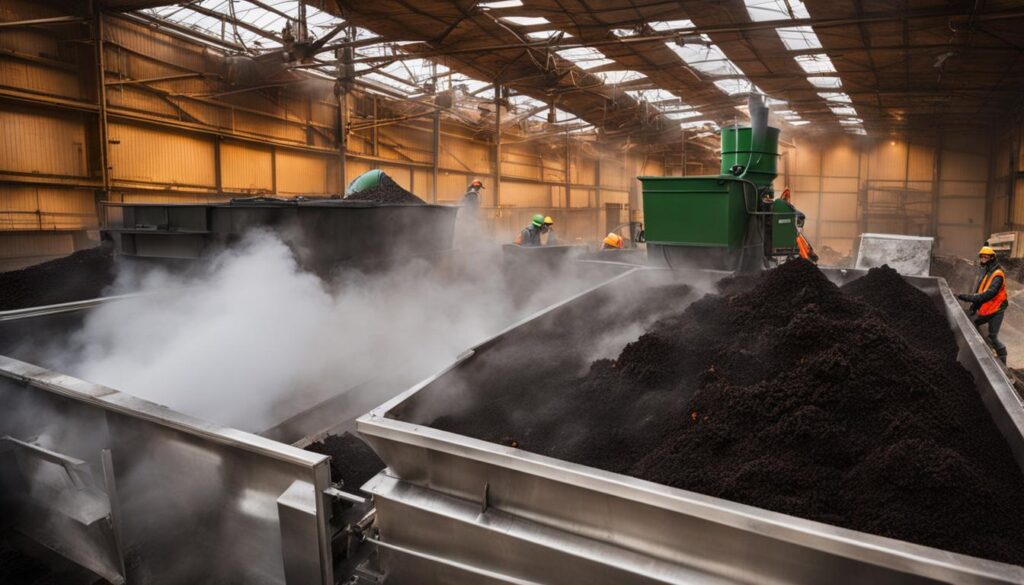
In-Vessel Composting is a highly efficient and controlled method of composting that takes place within enclosed containers or vessels.
This technique offers several advantages over traditional open pile composting methods. Firstly, the enclosed nature of the vessels ensures better temperature control, which accelerates the decomposition process.
Typically, these vessels are designed to maintain optimal moisture levels and aeration, creating an ideal environment for the growth of microorganisms responsible for breaking down organic matter. One commonly used type of in-vessel composting system is known as a rotating drum or barrel composter.
These drums are typically made from metal or heavy-duty plastic and can be manually turned or mechanically rotated to facilitate mixing and aeration. The continuous rotation helps distribute heat evenly throughout the compost, speeding up decomposition while also preventing odors from escaping.
Another popular form of in-vessel composting is using static aerated piles housed within concrete bunkers or tunnels. These systems employ blowers to force air into the chambers, promoting oxygen circulation and maintaining aerobic conditions necessary for effective decomposition.
The controlled environment inside the bunkers allows for precise monitoring of factors such as temperature, moisture levels, and carbon-to-nitrogen ratio – critical variables in achieving optimal compost quality. systems are particularly favored in urban areas where space may be limited or where odor control is crucial to prevent complaints from nearby residents.
Furthermore, these systems offer greater flexibility in managing various types of organic waste materials since they can handle not only yard trimmings but also food scraps, animal manure, and other organic residuals without attracting pests or causing nuisances associated with traditional open-air piles. Ultimately, in-vessel composting represents a significant advancement in waste management practices by providing an efficient solution to divert organic waste from landfills while simultaneously producing high-quality nutrient-rich soil amendments.
Its ability to operate year-round regardless of weather conditions makes it an attractive option for municipalities, farms, and other organizations seeking sustainable alternatives for managing organic waste. By harnessing the power of controlled decomposition within enclosed vessels, in-vessel composting contributes to a cleaner environment and promotes the circular economy by closing the loop on organic material utilization.
Community Composting
This is a practical and sustainable approach to waste management that encourages active participation from local residents.
It involves the collection and processing of organic waste within a specific community or neighborhood, transforming it into nutrient-rich compost that can be used to enrich soil and support plant growth. This decentralized method of composting not only reduces the burden on municipal landfills but also fosters a sense of environmental responsibility and community engagement.
One common form of community composting is backyard composting, where individuals or families manage their own compost piles in their yards or gardens. This allows them to conveniently dispose of kitchen scraps, yard trimmings, and other organic materials while simultaneously harnessing the benefits of nutrient recycling.
When exploring the different types of composting backyard composting offers numerous advantages for communities. This includes reducing greenhouse gas emissions associated with organic waste decomposition in landfills. It will also promote soil health and fertility, conserving water by improving soil moisture retention, and minimizing the need for synthetic fertilizers in gardening or farming practices. Another form of community composting involves shared facilities such as communal bins or vermicomposting systems.
These centralized infrastructure options are typically located in public spaces like parks or community gardens where residents can deposit their organic waste collectively. These facilities are often maintained by dedicated volunteers or local organizations who oversee the operations, ensuring proper maintenance and monitoring temperature levels to facilitate efficient decomposition.
Community members can contribute their food scraps and yard waste to these shared systems, allowing for a larger scale of compost production and utilization within the community. Community composting plays a vital role in creating sustainable waste management practices at the grassroots level.
By actively involving residents in the process of transforming organic waste into valuable resources like nutrient-rich compost, it empowers communities to take responsibility for their own environmental impact while fostering stronger social connections. Whether through individual backyard efforts or shared facilities, embracing community-based composting offers an accessible means for individuals to contribute positively towards managing organic waste effectively while reaping the benefits of improved soil health and sustainable gardening practices. Its a good idea to explore the different types of compost with your neighborhood today!
Windrow Composting

Windrow Composting is widely used and very effective method of composting organic materials. This technique involves the creation of long, narrow piles, known as windrows, where organic matter is allowed to decompose naturally. The windrows are typically constructed by layering the organic materials with bulking agents like wood chips or straw to facilitate aeration and provide structure.
One of the key advantages of windrow composting is its simplicity and low cost. It can be implemented on both small and large scales, making it accessible to various organizations and individuals interested in managing their organic waste sustainably.
The process begins with the collection of biodegradable materials such as food scraps, yard waste, or agricultural residues. These materials are then brought to a designated area where they are piled into long rows.
The size of the windrows plays a crucial role in achieving optimal decomposition rates; generally, windrows should be between 4 and 8 feet high and 14 to 18 feet wide. To ensure effective decomposition, regular monitoring is necessary during windrow composting.
Parameters such as temperature, moisture content, oxygen levels, and turning frequency need careful observation. Proper moisture levels (around 50-60%) promote microbial activity while preventing excessive drying or saturation that could hinder decomposition processes.
Maintaining adequate oxygen levels within the pile is crucial to support aerobic microbial activity responsible for breaking down organic matter efficiently. The piles must also be turned periodically using equipment like front-end loaders or specialized windrow turners.
Turning helps mix the outer parts with internal material that has not undergone proper decomposition yet, ensuring uniformity throughout the pile while preventing anaerobic conditions that could lead to unpleasant odors or incomplete breakdown. Overall, windrow composting provides an excellent option for those seeking a straightforward and cost-effective method to convert organic waste into nutrient-rich compost.
Its versatility makes it applicable in various settings ranging from small-scale backyard operations to large-scale industrial facilities dedicated to managing organic waste sustainably. With proper monitoring and management, windrow composting can yield high-quality compost that can be used to improve soil health and contribute to a more sustainable future.
Conclusion
Implementing different types of compost, can be an excellent way to provide your garden with the organic matter it needs to thrive. There are various types of compost available, each offering its own unique benefits. Whether you choose traditional composting, vermicomposting, trench composting, sheet mulching, bokashi composting, pit composting, aerated composting, compost tea, hot composting, or cold composting, the end goal is the same – to create nutrient-rich compost for your plants.
Organic compost, such as vermicompost, manure compost, green compost, and brown compost, is a natural and eco-friendly way to improve soil fertility and promote healthy plant growth. Kitchen compost and backyard compost are great options for utilizing household organic waste, while compost tea provides a convenient way to deliver nutrients to your plants directly.
When deciding on the best type of compost for your garden, consider your specific needs, available space, and level of involvement. Experiment with different types of compost to find what works best for you. By incorporating composting into your gardening routine, you’ll create a sustainable and thriving ecosystem that benefits both your plants and the environment.
So, start composting today and watch as your garden flourishes with the help of these different types of compost!
FAQ
What is compost?
Compost is a nutrient-rich organic matter that is created from the decomposition of organic waste materials, such as kitchen scraps, yard waste, and leaves. It is used to improve soil fertility and provide nutrients to plants.
Why should I use compost in my garden?
Compost is a fantastic way to supply nutrients and organic matter to your garden. It improves soil structure, helps retain moisture, promotes healthy plant growth, and reduces the need for chemical fertilizers.
What are the different types of compost?
There are various types of compost available, including traditional composting, vermicomposting, trench composting, sheet mulching, bokashi composting, pit composting, aerated composting, compost tea, hot composting, and cold composting. Each type has its own benefits and drawbacks, and choosing the right one depends on your specific needs and gardening goals.
How does traditional composting work?
Traditional composting involves creating a pile of organic materials, such as kitchen scraps, yard waste, and leaves, and allowing it to decompose over time. Regular turning and maintenance are required to ensure proper decomposition. Traditional composting is a great way to create nutrient-rich compost for your garden and improve soil fertility.
What is vermicomposting?
Vermicomposting is a process that involves using worms to break down organic waste materials. It is typically done in a worm bin or vermicomposting system. The worms consume the organic waste and produce nutrient-rich worm castings, which can be used as compost. Vermicomposting is a great option for those with limited space or who want to compost indoors.
How does trench composting work?
Trench composting is a method where compostable materials, such as vegetable scraps, are buried directly into the garden bed. This process eliminates the need for a compost bin or pile. Simply dig a trench, add the organic materials, and cover them with soil. Over time, the organic matter will break down and enrich the soil. Trench composting is a convenient way to compost while simultaneously improving the soil in your garden.
What is sheet mulching or lasagna gardening?
Sheet mulching, also known as lasagna gardening, involves layering organic materials to create a composting effect. Start by laying down a layer of cardboard or newspaper to smother weeds, then add alternating layers of compostable materials, such as grass clippings, leaves, kitchen scraps, and straw. As the layers break down, they enrich the soil and suppress weed growth. Sheet mulching is a simple and effective way to compost while simultaneously creating new garden beds.
What is bokashi composting?
Bokashi composting is a Japanese method of composting that involves fermenting organic waste using beneficial microorganisms. This process is done in an airtight container and does not require oxygen. Bokashi composting can effectively break down kitchen waste, including meat, dairy, and cooked food, which may not be suitable for other composting methods. The resulting fermented compost, known as bokashi, can be buried in the soil or added to a traditional compost bin to further decompose.
How does pit composting work?
Pit composting involves digging a hole in your garden and filling it with organic matter, such as garden waste, leaves, and kitchen scraps. The hole is then covered with soil and left to decompose. This method is simple and effective, as it allows the organic matter to break down directly in the soil, improving its fertility. Pit composting is especially beneficial for large amounts of organic waste or when space is limited for traditional composting methods.
What is aerated composting?
Aerated composting involves using a compost tumbler or compost bin with built-in aeration systems to speed up the decomposition process. These systems provide oxygen to the organic matter, allowing for faster and more efficient composting. Aerated composting is a great option for those who want to compost quickly and without the need for regular turning.
What is compost tea?
Compost tea is a liquid fertilizer made from steeping compost in water. It is created by soaking compost in water for a period of time, then straining out the solid particles to obtain the nutrient-rich liquid. Compost tea can be used as a foliar spray or soil drench to provide plants with a boost of nutrients. It is an excellent way to deliver the benefits of compost directly to the roots of plants.
What is hot composting?
Hot composting is a method that involves creating and maintaining high temperatures in a compost bin or pile. This rapid decomposition process requires a balance of nitrogen-rich and carbon-rich materials, regular turning, and proper moisture levels. Hot composting generates heat that speeds up the breakdown of organic matter, resulting in fast and efficient composting.
What is cold composting?
Cold composting is a slower and more passive method of composting. It involves piling up organic materials and allowing them to break down naturally over time without any specific maintenance or turning. While cold composting takes longer than hot composting, it requires less effort and is suitable for those who prefer a low-maintenance approach to composting.

